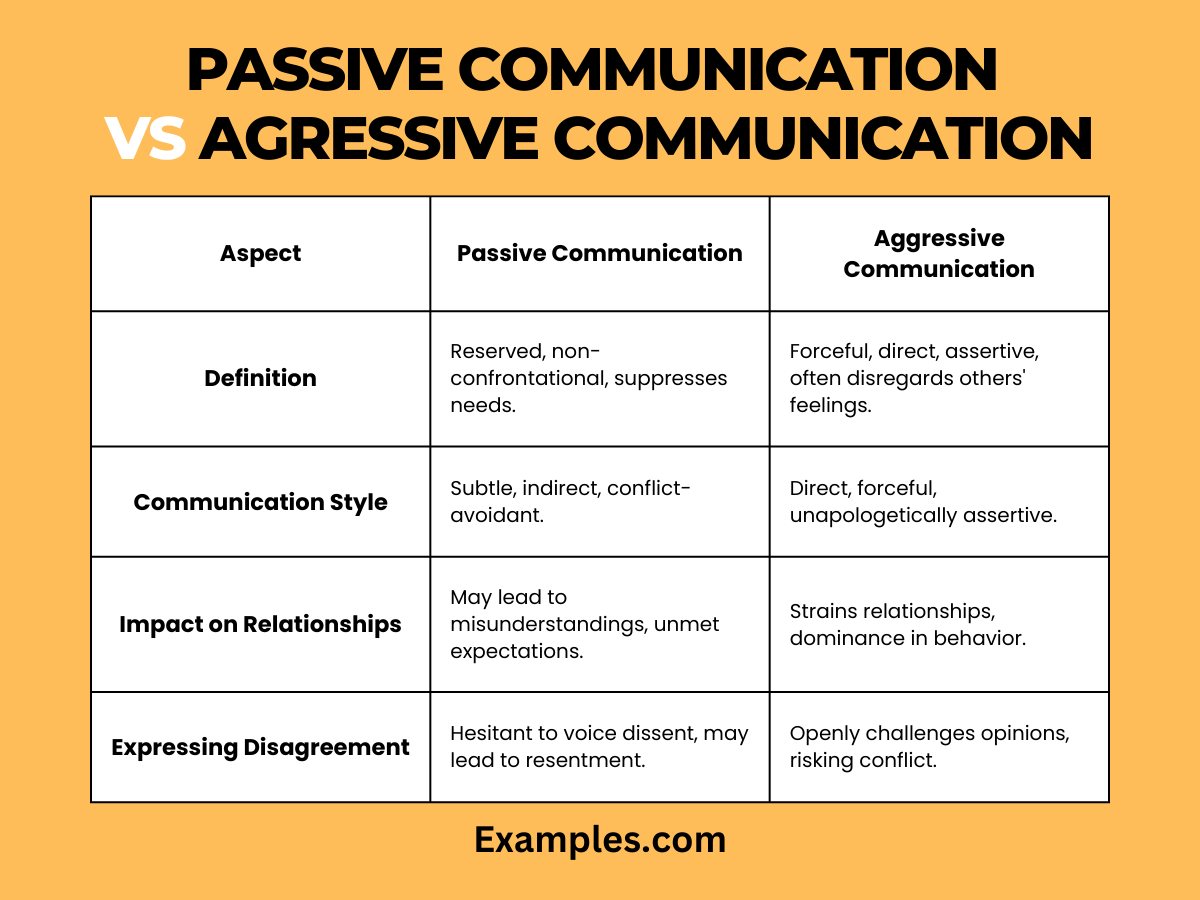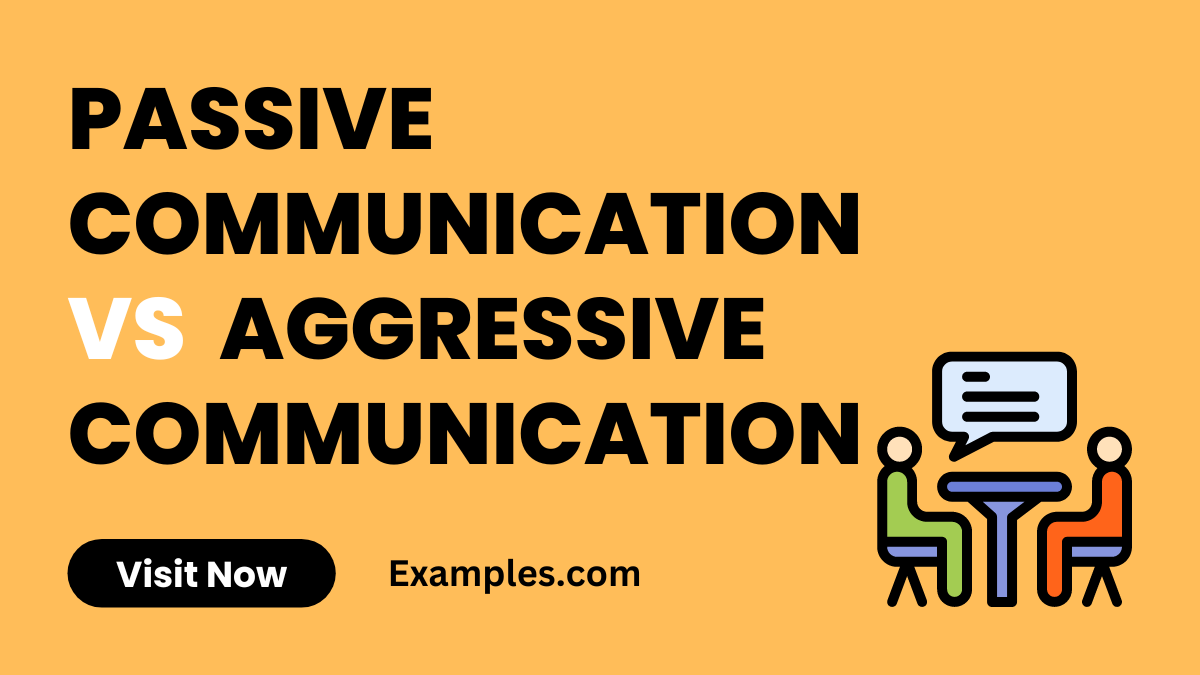Passive Communication vs Aggressive Communication – 19+ Examples
Embark on a journey through the nuanced realms of Passive Communication vs Aggressive Communication! 🌐 Explore this comprehensive guide, teeming with vivid Communication Examples to illuminate the art of balancing assertiveness and restraint. Elevate your interpersonal finesse by grasping the subtleties of effective communication in various situations.
Difference Between Passive Communication and Aggressive Communication
In the arena of interpersonal dynamics, understanding Passive Communication vs Aggressive Communication is pivotal. Dive deep into their distinctions, unveiling the subtleties that shape relationships and interactions. Equip yourself with insights into the psychological underpinnings, enabling you to navigate diverse communication styles effectively.

| Aspect | Passive Communication | Aggressive Communication |
|---|---|---|
| Definition | Emphasizes a reserved, non-confrontational approach, often suppressing one’s needs. | Prioritizes forceful expression, often at the expense of others’ feelings. |
| Communication Style | Subtle, indirect, and tends to avoid conflict. | Direct, forceful, and unapologetically assertive. |
| Impact on Relationships | May lead to misunderstandings and unmet expectations. | Can strain relationships due to dominating behaviour. |
| Expressing Disagreement | Hesitant to voice dissent, potentially leading to resentment. | Openly challenges opinions, risking conflict and tension. |
| Handling Criticism | Often internalizes criticism, avoiding confrontation. | Responds defensively, possibly escalating conflicts. |
| Assertiveness Levels | Low assertiveness, struggling to express personal needs. | High assertiveness, often prioritizing personal needs over others’. |
| Conflict Resolution Approach | Avoids conflict or gives in, compromising personal stance. | Confrontational, seeking to win arguments at the expense of cooperation. |
| Nonverbal Cues | Relies on subtle body language, avoiding direct eye contact. | Uses dominant body language, maintaining intense eye contact. |
| Effect on Mental Health | May lead to internal frustration and unexpressed emotions. | Can contribute to stress, impacting mental well-being of others. |
10 Passive Communication Examples
Embrace the profound advantages of passive communication, a subtle yet impactful approach. Enhance interpersonal connections, foster cooperation, and navigate conflicts with finesse. Discover the strategic benefits that emanate from a calm and composed communication style, contributing to personal growth and harmonious relationships.
- Meeting Interruption: Maintain composure, allowing others to finish their thoughts before calmly expressing your perspective.
- Team Collaboration: Encourage team members by actively listening, offering support, and avoiding confrontational language.
- Receiving Feedback: Embrace feedback gracefully, acknowledging input and expressing a commitment to improvement.
- Conflict Resolution: Approach conflicts with a calm demeanour, emphasizing understanding and seeking mutually beneficial solutions.
- Project Delegation: Delegate tasks diplomatically, considering individual strengths and providing clear expectations.
- Handling Criticism: Respond to criticism with grace, focusing on constructive aspects and expressing a willingness to learn.
- Cross-functional Communication: Navigate diverse perspectives by actively listening, seeking common ground, and avoiding aggressive tones.
- Client Interactions: Approach clients with a patient and empathetic demeanour, ensuring their concerns are addressed effectively.
- Performance Appraisals: Provide constructive feedback with tact, emphasizing areas of improvement while acknowledging achievements.
- Navigating Workplace Changes: Address organizational changes with a positive outlook, encouraging adaptability among colleagues.
10 Aggressive Communication Examples
Unlock the potential behind Aggressive Communication, a powerful yet risky communication style. Explore its benefits, revealing how assertiveness can drive results. Delve into the intricacies of Aggressive Communication to harness its advantages without succumbing to its pitfalls.
- Confidence Catalyst: Harness the power of directness in Aggressive Communication to boost self-confidence. Boldly express opinions, fostering an environment where your voice is heard.
- Prompt Decision-Making: In fast-paced scenarios, Aggressive Communication streamlines decision-making. Cut through ambiguity with assertive clarity, ensuring swift and effective resolutions.
- Setting Boundaries: Aggressive communicators excel in boundary-setting. Learn how to establish clear limits, safeguarding personal and professional spaces with assertive communication.
- Assertive Leadership: Leadership thrives on assertiveness. Uncover how Aggressive Communication can shape strong leadership qualities, inspiring teams and driving success.
- Conflict Resolution Dynamism: Navigate conflicts adeptly using Aggressive Communication as a tool for resolution. Turn confrontation into constructive dialogue, fostering growth and understanding.
- Expressive Influence: Leverage Aggressive Communication to exert influence. Explore the art of impactful expression, driving change and garnering support for your ideas.
- Negotiation Precision: Master the negotiation table with Aggressive Communication techniques. Achieve favourable outcomes by asserting your needs confidently and persuasively.
- Performance Enhancement: Discover how Aggressive Communication contributes to performance improvement. Drive efficiency by setting high standards and communicating expectations assertively.
- Crisis Management: In crisis situations, Aggressive Communication becomes a potent crisis management tool. Communicate decisively, instilling confidence and rallying support.
- Assertive Networking: Unlock the networking potential of Aggressive Communication. Learn to assert yourself positively, forging connections and leaving a lasting impression.
Comparison Between Passive Communication and Aggressive Communication
Navigating the spectrum of communication styles, understanding the nuances of Passive and Aggressive Communication is crucial for effective interaction. This comprehensive guide delves into the comparison between these polarizing approaches, offering insights to help you strike the right balance in various scenarios.
- Understanding Passive Communication: Passive communication often involves hesitation, avoidance, or a reluctance to assert oneself. Explore the characteristics of this style, recognizing its potential advantages and limitations.
- Decoding Aggressive Communication: On the opposite end, Aggressive Communication manifests as assertiveness pushed to the extreme. Uncover the traits and behaviours associated with this approach, highlighting its impact on relationships and outcomes.
- Communication Styles in Conflict: Delve into how Passive and Aggressive Communication manifest in conflict scenarios. Understand the dynamics of passive avoidance and aggressive confrontation, exploring strategies for resolution.
- Impact on Relationships: Explore the impact of communication styles on interpersonal relationships. Analyse how passive tendencies may lead to misunderstandings, while aggression might strain connections. Discover methods to foster healthy communication dynamics.
- Workplace Dynamics: Assess how Passive and Aggressive Communication play out in professional settings. Understand their effects on team dynamics, productivity, and overall work culture.
- Emotional Intelligence in Communication: Uncover the role of emotional intelligence in balancing communication styles. Learn to navigate emotions effectively, fostering a more harmonious interaction between passive and aggressive tendencies.
- Adaptive Communication Strategies: Recognize the need for adaptive communication. Explore how a blend of passive and aggressive elements, depending on the context, can enhance your ability to express yourself appropriately.
- Self-Awareness and Growth: Foster self-awareness to recognize personal communication tendencies. Discover growth opportunities, acknowledging the strengths of each style while addressing areas for improvement.
- Effective Communication Models: Investigate models that incorporate elements of both Passive and Aggressive Communication. Understand how adopting a balanced approach can lead to more effective and positive outcomes.
- Striking a Balance: Conclude by exploring the art of striking a balance between passive and aggressive communication. Develop a nuanced, adaptable communication style that aligns with diverse situations and relationships.
Relationship between Passive Communication and Aggressive Communication
Understanding the intricate dance between Passive and Aggressive Communication unveils a nuanced spectrum of interpersonal dynamics. The relationship between these communication styles influences interactions in various settings, shaping relationships, and impacting outcomes.
- Power Struggle Dynamics: Passive Communication often aligns with a more submissive stance, yielding to the assertiveness of Aggressive Communication. Explore how power imbalances emerge and influence the dynamics between individuals.
- Impact on Collaboration: Examine the collaborative landscape where Passive and Aggressive Communication intersect. Discover how these styles can either harmonize or clash, affecting teamwork, creativity, and overall productivity.
- Communication Styles in Conflict: Delve into conflict scenarios to dissect how Passive and Aggressive Communication contribute to or alleviate tension. Uncover strategies for navigating conflicts when these styles collide.
- Influence on Organizational Culture: Explore the imprint of Passive and Aggressive Communication on organizational culture. Understand how these communication styles contribute to the creation of a healthy or toxic work environment.
- Role in Leadership: Investigate the influence of Passive and Aggressive Communication on leadership dynamics. Analyse how these styles impact a leader’s ability to inspire, motivate, and guide a team effectively.
- Psychological Underpinnings: Uncover the psychological factors that underlie Passive and Aggressive Communication. Examine how individual traits, experiences, and perceptions shape these communication styles.
- Navigating Interpersonal Relationships: Understand how individuals with differing communication styles can navigate relationships effectively. Explore strategies for fostering understanding and bridging communication gaps.
- Striking a Balance: Discover the delicate equilibrium between Passive and Aggressive Communication. Learn how individuals can adapt their communication styles to promote healthier interactions and more positive outcomes.
- Impact on Personal Growth: Reflect on the personal growth opportunities presented by navigating the interplay between Passive and Aggressive Communication. Explore how adapting communication styles can contribute to individual development.
- Communication Transformation Strategies: Conclude with actionable strategies for transforming communication dynamics positively. Provide insights into how individuals can evolve their communication styles for improved relationships and collaboration.
In the intricate dance of human communication, the interplay between Passive and Aggressive Communication styles shapes our relationships and outcomes. Understanding their relationship unveils strategies for fostering healthier dynamics. By delving into the nuances, individuals can navigate interactions with empathy, adaptability, and a conscious effort to transform communication for the better. Explore the guide to cultivate positive connections in diverse scenarios.



